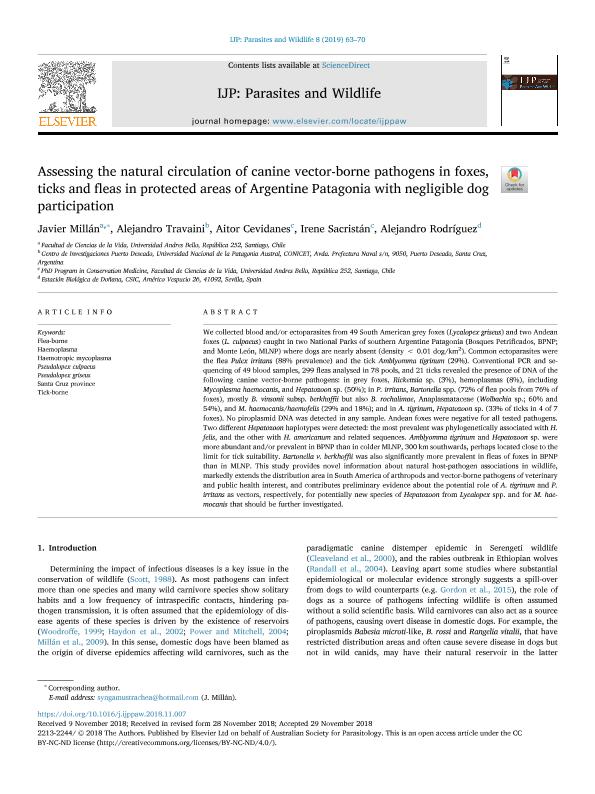Artículo
Assessing the natural circulation of canine vector-borne pathogens in foxes, ticks and fleas in protected areas of Argentine Patagonia with negligible dog participation
Millán, Javier Maximiliano; Travaini, Alejandro ; Cevidanes, Aitor; Sacristán, Irene; Rodríguez, Alejandro
; Cevidanes, Aitor; Sacristán, Irene; Rodríguez, Alejandro
 ; Cevidanes, Aitor; Sacristán, Irene; Rodríguez, Alejandro
; Cevidanes, Aitor; Sacristán, Irene; Rodríguez, Alejandro
Fecha de publicación:
04/2019
Editorial:
Elsevier
Revista:
International Journal for Parasitology: Parasites and Wildlife
ISSN:
2213-2244
Idioma:
Inglés
Tipo de recurso:
Artículo publicado
Clasificación temática:
Resumen
We collected blood and/or ectoparasites from 49 South American grey foxes (Lycalopex griseus) and two Andean foxes (L. culpaeus) caught in two National Parks of southern Argentine Patagonia (Bosques Petrificados, BPNP; and Monte León, MLNP) where dogs are nearly absent (density < 0.01 dog/km2). Common ectoparasites were the flea Pulex irritans (88% prevalence) and the tick Amblyomma tigrinum (29%). Conventional PCR and sequencing of 49 blood samples, 299 fleas analysed in 78 pools, and 21 ticks revealed the presence of DNA of the following canine vector-borne pathogens: in grey foxes, Rickettsia sp. (3%), hemoplasmas (8%), including Mycoplasma haemocanis, and Hepatozoon sp. (50%); in P. irritans, Bartonella spp. (72% of flea pools from 76% of foxes), mostly B. vinsonii subsp. berkhoffii but also B. rochalimae, Anaplasmataceae (Wolbachia sp.; 60% and 54%), and M. haemocanis/haemofelis (29% and 18%); and in A. tigrinum, Hepatozoon sp. (33% of ticks in 4 of 7 foxes). No piroplasmid DNA was detected in any sample. Andean foxes were negative for all tested pathogens. Two different Hepatozoon haplotypes were detected: the most prevalent was phylogenetically associated with H. felis, and the other with H. americanum and related sequences. Amblyomma tigrinum and Hepatozoon sp. were more abundant and/or prevalent in BPNP than in colder MLNP, 300 km southwards, perhaps located close to the limit for tick suitability. Bartonella v. berkhoffii was also significantly more prevalent in fleas of foxes in BPNP than in MLNP. This study provides novel information about natural host-pathogen associations in wildlife, markedly extends the distribution area in South America of arthropods and vector-borne pathogens of veterinary and public health interest, and contributes preliminary evidence about the potential role of A. tigrinum and P. irritans as vectors, respectively, for potentially new species of Hepatozoon from Lycalopex spp. and for M. haemocanis that should be further investigated.
Archivos asociados
Licencia
Identificadores
Colecciones
Articulos(SEDE CENTRAL)
Articulos de SEDE CENTRAL
Articulos de SEDE CENTRAL
Citación
Millán, Javier Maximiliano; Travaini, Alejandro; Cevidanes, Aitor; Sacristán, Irene; Rodríguez, Alejandro; Assessing the natural circulation of canine vector-borne pathogens in foxes, ticks and fleas in protected areas of Argentine Patagonia with negligible dog participation; Elsevier; International Journal for Parasitology: Parasites and Wildlife; 8; 4-2019; 63-70
Compartir
Altmétricas



